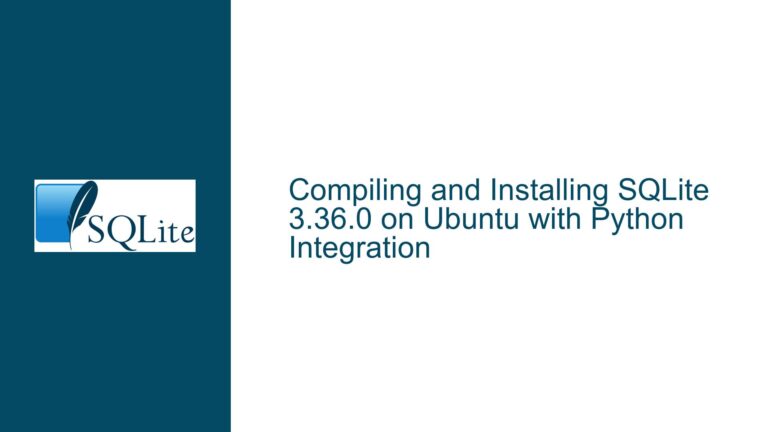Optimizing SQLite Database Connections: Open vs. Close Strategies and Power Failure Implications
Understanding the Impact of Frequent Database Open/Close Operations on Performance and Data Integrity
When working with SQLite, one of the most common dilemmas developers face is whether to keep the database connection open for extended periods or to open and close it frequently, especially in scenarios where data insertion operations occur at a high frequency. This decision is not merely a matter of preference but has significant implications for both performance and data integrity.
SQLite is a lightweight, serverless database engine that is designed to be embedded within applications. Unlike client-server databases, SQLite does not require a separate server process to operate. Instead, it reads and writes directly to ordinary disk files. This design choice makes SQLite highly efficient for many use cases but also introduces unique considerations when it comes to managing database connections.
Frequent opening and closing of the database connection can lead to performance overhead. Each time the database is opened, SQLite must perform several initialization tasks, such as acquiring file locks, reading the database schema, and preparing the environment for subsequent operations. Similarly, closing the database involves releasing resources, flushing caches, and ensuring that all pending changes are written to disk. These operations, while seemingly trivial, can accumulate significant overhead when performed repeatedly in a short time frame.
On the other hand, keeping the database connection open for extended periods can also pose challenges. One of the primary concerns is the risk of data corruption in the event of a power failure or application crash. SQLite employs a transactional model to ensure data integrity, but this model relies on the ability to write changes to disk in a controlled manner. If the database connection remains open during a power failure, any uncommitted transactions may be lost, and in some cases, the database file itself may become corrupted.
The key to resolving this dilemma lies in understanding the role of transactions in SQLite. Transactions are the fundamental unit of work in SQLite, and they provide a mechanism for grouping multiple operations into a single, atomic unit. When a transaction is committed, SQLite ensures that all changes made within that transaction are written to disk in a durable manner. If a transaction is not committed, either due to an explicit rollback or an unexpected failure, SQLite guarantees that none of the changes are applied, thus maintaining the consistency of the database.
Given this context, the decision to open and close the database frequently or to keep it open should be guided by the transactional boundaries rather than the database connection itself. By carefully managing transactions, developers can minimize the performance overhead associated with frequent database opens and closes while also safeguarding against data loss or corruption in the event of a power failure.
Exploring the Role of Transactions in Mitigating Power Failure Risks
The risk of data loss or corruption due to power failure is a critical concern when working with SQLite, especially in environments where the database is expected to handle frequent data insertions. SQLite’s transactional model is designed to address this concern by ensuring that changes to the database are atomic, consistent, isolated, and durable (ACID). However, the effectiveness of this model depends on how transactions are managed.
When a power failure occurs, the state of the database depends on the state of any active transactions at the time of the failure. If a transaction was in progress but not yet committed, SQLite’s rollback journal or write-ahead log (WAL) ensures that the database can be restored to its previous consistent state. However, if the failure occurs while a transaction is being committed, the outcome depends on whether the commit operation had completed successfully before the failure.
In the default rollback journal mode, SQLite uses a two-phase commit process to ensure that changes are written to disk in a durable manner. During the first phase, the changes are written to the rollback journal, and during the second phase, the changes are applied to the database file. If a power failure occurs during the first phase, the rollback journal contains the necessary information to undo the changes. If the failure occurs during the second phase, the rollback journal is used to complete the commit operation when the database is next opened.
In WAL mode, SQLite uses a different approach to achieve durability. Instead of writing changes directly to the database file, SQLite appends the changes to a separate write-ahead log file. The database file is updated asynchronously, and a checkpoint operation is used to transfer the changes from the WAL file to the database file. This approach allows for greater concurrency and can improve performance in some scenarios, but it also introduces additional complexity when it comes to handling power failures.
Regardless of the journaling mode, the key to mitigating power failure risks is to ensure that transactions are kept as short as possible. Long-running transactions increase the window of vulnerability during which a power failure could result in data loss or corruption. By breaking down large operations into smaller, more manageable transactions, developers can reduce the risk of data loss and improve the overall robustness of the database.
Best Practices for Managing SQLite Database Connections and Transactions
To optimize the performance and reliability of an SQLite database in scenarios involving frequent data insertions, developers should adopt a set of best practices for managing database connections and transactions. These practices are designed to minimize the overhead associated with frequent database opens and closes while also ensuring that the database remains resilient to power failures and other unexpected events.
First and foremost, developers should aim to keep the database connection open for the duration of the application’s lifecycle, or at least for the duration of a logical unit of work. This approach reduces the overhead associated with repeatedly opening and closing the database and allows SQLite to maintain its internal caches and state across multiple operations. However, this does not mean that the connection should remain open indefinitely. Developers should still close the connection when it is no longer needed, such as when the application is shutting down or transitioning to a different phase of operation.
Within the context of an open database connection, developers should use transactions to group related operations into atomic units. Each transaction should be kept as short as possible to minimize the risk of data loss or corruption in the event of a power failure. When inserting multiple rows of data, developers should consider using batch inserts within a single transaction rather than committing each insert individually. This approach reduces the number of commit operations and can significantly improve performance.
In addition to managing transactions, developers should also consider the journaling mode used by SQLite. The default rollback journal mode is suitable for most use cases, but WAL mode may offer performance benefits in scenarios with high levels of concurrency. When using WAL mode, developers should be aware of the additional complexity involved in handling power failures and should ensure that checkpoint operations are performed regularly to transfer changes from the WAL file to the database file.
Finally, developers should implement robust error handling and recovery mechanisms to deal with unexpected events such as power failures. This includes regularly backing up the database, monitoring the health of the database file, and using SQLite’s built-in tools to detect and repair any corruption that may occur. By following these best practices, developers can ensure that their SQLite databases remain performant, reliable, and resilient in the face of frequent data insertions and other challenges.
In conclusion, the decision to open and close an SQLite database frequently or to keep it open should be guided by the transactional boundaries and the specific requirements of the application. By carefully managing transactions, choosing the appropriate journaling mode, and implementing robust error handling and recovery mechanisms, developers can optimize the performance and reliability of their SQLite databases while minimizing the risk of data loss or corruption.






